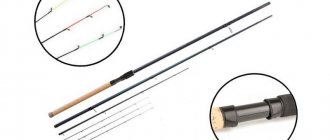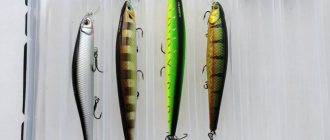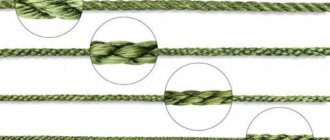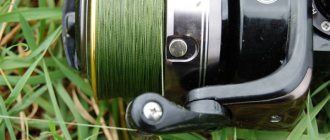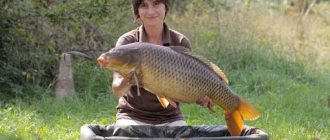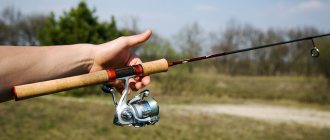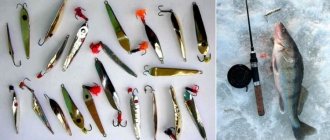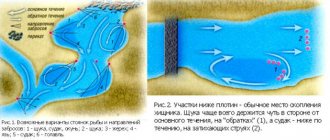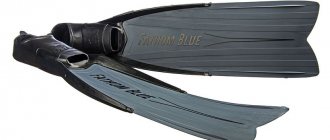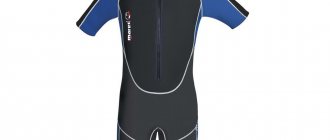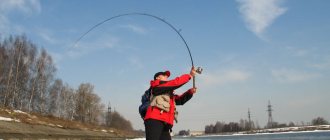Rod parameters and their characteristics, depending on the material of manufacture
Gone is the era of bamboo poles, now the angler is given a choice of blanks made of fiberglass composite or plastic, and each of them has its own disadvantages and advantages.
Fiberglass fishing rods are very popular among fishermen, since the cost of such fishing rods is relatively low, and they do not require special care during operation. Since their strength is almost not affected by microcracks that they receive during transportation. Important parameters of such fishing rods are their good flexibility and ability to withstand heavy loads. Unfortunately, this comes at the expense of sensitivity, and they also weigh more compared to similar sized carbon fiber and composite rods.
Carbon (graphite, carbon fiber) fishing rods are marked Carbon. It is believed that fishing rods made from this material are more modern and better suited for professional fishing. The quality characteristics of the rod are its lightness, fairly high sensitivity and good strength.
Carbon fishing rods differ depending on the graphite content module, which has values in the range IM-1 - IM-10 (there are fishing rods with other indicators, for example GL2, IMX); the marking of the graphite module must be presented on the form. Rods with a low modulus of graphite content 1,2,3,4 are not so fragile, quite strong, soft and elastic, but they are significantly inferior when a sharp hook is needed. But rods that have a high modulus index are more rigid and sensitive, and they are good to use for casting over long distances, as well as for fishing at dusk, since you can feel the movement of the bait with your hand. True, when using them, you should take care of the safety of the rod: transport it in a tube and avoid hitting rocks. It is also worth remembering that the rod conducts current, so it is better not to pick it up during a thunderstorm, and you should be careful near live parts of the machine and electrical wires. The quality parameters of a rod made of bi-spiral carbon are very high; these blanks have good strength and ductility, without losing sensitivity.
Composite fishing rods are made of carbon fiber reinforced with fiberglass. Thanks to this alloy we get a rod with average values:
relative affordability compared to carbon rods;
good casting range;
moderate hardness and good strength.
Spinning line
The fishing line is an important element of spinning tackle; it serves as a connecting link between the bait and the rod. There are three main types of fishing lines used in spinning rods: monofilament, braided fishing line (cords) and fluorocarbon fishing line. Each of these types of fishing line has its own characteristics, advantages and disadvantages.
- Monofilaments
are the oldest type of fishing line. Mono lines have a low cost, low visibility in the water, due to their stretchability, they are good at damping fish jerks. The disadvantages of monofilament include low strength and stretchability, due to which they do not provide high sensitivity of the gear. - Braided fishing lines (cords)
do not consist of one fiber, like monofilaments and fluorocarbon fishing lines, but of several fibers woven together. Braided fishing lines are practically inextensible, which ensures full contact with the bait and the highest sensitivity of the gear. Braided fishing lines have high tensile strength, exceeding the strength of all other types of fishing line. With the same diameter, braided fishing line is 3-5 times stronger than monofilament. Braided fishing lines, unlike monofilaments, do not have a memory effect. Without the use of braided lines, it is impossible to imagine such methods of spinning fishing as jig, twitching and jerking. The disadvantages of braided lines are their higher cost, as well as their increased susceptibility to abrasion. - Fluorocarbon lines
have a light refractive index close to that of water, so they are almost completely invisible in water. Another significant advantage of fluorocarbon fishing lines is their high abrasion resistance.
When catching predatory fish that have sharp teeth that can easily cut the fishing line, the fisherman attaches a leash between the main fishing line and the bait. The leash can be made of different materials: metal braided cable, guitar string, fluorocarbon or monofilament. The most common are leashes made of metal braided cable; they can be of different lengths and workmanship; they can be bought at any fishing store. Popular among spinning anglers are leashes made of guitar string or other steel wire with a diameter of 0.18 to 0.40 mm. Many anglers use a piece of fluorocarbon fishing line with a diameter of 0.35 - 0.7 mm for the leash.
You may be interested: Jackall Tiny Fry is not an easy fryer
Rod classes
As you know, there are different types of fishing rods: float rods, spinning rods, feeder rods, fly rods, and each type of rod has its own classification parameters. Only the classification of fly fishing rods depends on the class of their equipment.
The power of a spinning rod is determined by its test - the weight of the bait at which you can comfortably fish with a spinning rod without breaking it or losing sensitivity due to the low weight of the bait. Thanks to this parameter, spinning rods can be divided into 7 classes and you can determine which spinning rod is best to choose for successful fishing .
- Ultra - light , Ultra Light, UL - the weight of the cast bait is 1-7 g.
- Light , Light, L – the weight of the bait being thrown is 3-14 g.
- Medium - light , Medium Light, ML - the weight of the thrown bait is 5-20 g.
- Medium , Medium, M - the weight of the bait being thrown is 10-30 g.
- Medium - heavy , Medium Heavy, MH weight of the bait thrown - 15-40 g.
- Heavy, Heavy , H - the weight of the bait being thrown is 20-50 g.
- Extra - heavy , Extra Heavy, EH - the weight of the thrown bait is from 60 g.
The characteristics of float rods by class are not so diverse, and depend on the length and weight of the rod:
- Light rods - Light - L have a weight of up to 150 g and a length of up to 2.5 m.
- rods weigh up to 250 g and length up to 5 m.
- fishing rods have a weight of up to 300 g and a length of over 6 m.
The classification of feeder rods depends on the blank test
- Light , Light test rods up to 40 g, while the weight of the feeder should not exceed 20-30 g.
- Average Medium test from 40 to 80 g.
- Heavy Heavy test from 80 to 120 gr.
- Extra - heavy , Extra Heavy - test above 120 g.
Passing rings
One of the most important parts of a spinning rod is the guide rings. The purpose of the guide rings is not just to hold the cord, but also to ensure minimal friction between the ring and the fishing line.
The material from which the rings are made plays an important role. The rings are of poor quality; from constant friction of the fishing line or cord against the ring, grooves form on the rings. Rings with such grooves literally wear out the fishing line in just a few casts and rewinds, which breaks during the next cast and the bait is shot. Bypass rings with defects cannot properly perform their intended functions and must be replaced.
You may be interested in: PVC boats
The number of throughput rings depends on the length of the spinning rod and the degree of its rigidity. The passage ring on the top of the spinning rod is called a “tulip”. Spinning rod guide rings can be made entirely of metal, or have a metal base with a ceramic, Teflon or fluoroplastic insert inside the ring. The best rings today are those with Alconite (black) and SIC (gray) inserts.
The inserts must be firmly held inside the passage rings without turning. The guide rings themselves must be firmly and tightly wound with thread to the rod blank.
Characteristics of the rod structure
The action of a fishing rod is a characteristic that shows how much the blank will bend if a load is applied to it.
Rod build
- The rod has an extra fast action (Extra Fast) when the blank is loaded, it bends in 1/4 of its upper part
- Fast action rod – when the blank is loaded, a bend occurs in 1/3 of its upper part. As a result, such a form quickly takes its original shape after removing the load.
- The rod is medium-fast (Medium-Fast) when the blank is loaded, bending occurs in more than 1/3 of the upper part of the blank, but less than half the length of the upper part
- A medium action rod (Medium) when the blank is loaded, it bends in its upper half.
- A slow-action rod (Slow) in this case, when loaded, the blank will bend along the entire length of the rod, resembling the branch of a parabola, which is why these rods are also called parabolics, besides, after removing the load, they will take their original shape much longer.
Therefore, when choosing a fishing rod, it is very important to pay attention to such rod parameters as its action, since fast action rods are often stronger, but parabolic rods make it possible to absorb the jerks of the fish, thereby reducing the load on the blank.
Test as one of the main parameters of a fishing rod
Casting or testing is another important parameter of a fishing rod. The definition itself means the smallest and largest weight of baits at which the selected fishing rod can be used.
Rod test
As an example, let’s look at one of the most standard cases, when on the form of a fishing rod you see the inscription 10-30 G. What does this characteristic of a fishing rod mean? The number 10 shows the smallest weight of the bait, tackle (in cases of float fishing, the weight of the float plus sinkers) at which you can successfully fish. So, if you use baits that weigh less than the specified value, then you will have problems when casting, and when jig fishing, you will not be able to feel your hand touching the bottom with the bait. But you should not rely heavily on the accuracy of the indicated value, but use bait with a reserve, so in this case, it is better to take a bait of at least 13 grams. Accordingly, 30 shows that the maximum weight of the bait should not exceed 30 grams. Using heavier baits will quickly ruin your rod. Although it is better to use attachments 3-5 grams less than the specified weight.
In general, the optimal lures will be those that have an average weight, for example, for a rod with a test weight of 10-30 g. It is more effective to take baits weighing 18-22 grams. Especially if we are talking about feeder rods, where in addition to the weight of the feeder itself, it is worth taking into account the weight of the bait.
Spinning baits
When fishing with spinning rods, anglers use a variety of types of artificial baits:
- Spinner baits
are the most popular spinning lures among anglers. According to many, a spinner is the best bait for an angler starting to fish with a spinning rod. A rotating spoon is a metal petal rotating around a metal axis. With its rotation, the petal attracts the attention of predatory fish. Rotating spoons differ in the size and shape of the petal, its color, and the weight of the spoon. The spinners are capable of provoking any predatory fish to attack.
- Oscillating spoons
are a time-tested method of catching fish using a spinning rod and have been tested by thousands of anglers. Nowadays, there are many more modern spinning lures made of silicone or plastic, but oscillating spoons are still used by many anglers. In appearance, oscillating spoons are curved metal plates of oval or elongated shape; they can be of a variety of shapes: wide, narrow, flattened and elongated. The choice of color and shape of the spoon depends on the reservoir where fishing is carried out and the fishing conditions. The spinner imitates a fish escaping from a predator pursuing it. The appearance of the spinner plays a less important role compared to its performance. Predatory fish, in pursuit of prey, are primarily oriented by the lateral line organ, which perceives the vibration coming from the prey, and only secondarily by vision, which is why the correct play of the oscillating spoon in the water is so important.
- Wobblers
are voluminous baits made of wood or plastic that are used for fishing with spinning or trolling.
Translated from English, the word wobbler
means to swing, move, waddle. Indeed, the wobbler imitates with its play a wounded, fleeing fish, which rolls from side to side, staggers and sways, provoking the predator to attack with its entire appearance and behavior. The body of the wobbler can be made of wood (balsa, pine, hickory or oak) or plastic (ABC, polystyrene, polycarbonate or expanded polystyrene). According to their design, all wobblers are divided into bladed and bladeless. Bladed wobblers have a special blade in their front part, which causes the wobbler to oscillate and go deep to a certain depth. According to their shape, bladed wobblers are distinguished: minnow, shad, crank, fat. There are a large number of types of bladeless wobblers: poppers, walkers, gliders, jerkbaits, swimbaits, stickbaits, rattlins. Wobblers differ in the degree of buoyancy into three large groups: floating, sinking and suspenders. Wobblers also differ in several classes according to the degree of depth. The depth of the wobbler tells the angler how deep from the surface of the water the wobbler will be when the angler reels in the fishing line.
- Silicone baits
are
soft baits simulating insects, crustaceans, worms, fry and other food items for fish. Most often they are made of elastic silicone, rubber or other soft materials. Thanks to their elastic body, silicone baits wriggle beautifully in the water when retrieved, creating hydroacoustic vibrations and thereby attracting predators from a great distance. Silicone baits can be of different types in shape: twisters, vibrotails, octopuses, worms, crustaceans and others. Manufacturers add salt and special aromatic attractants to some silicone baits, which with their taste and smell additionally attract fish and force them not to immediately spit out the bait, but to hold it in their mouth longer. Such rubber is called “edible”, and those silicone baits that have no taste or smell are called “inedible rubber”. For fishing, silicone baits are mounted on a jig head, on an offset hook or double with a Cheburashka weight, or using special spaced equipment, such as a drop shot or a retractable leash.
You can read more about what a drop shot is, its advantages and disadvantages, what kind of fish and when you can catch with it, about the correct installation of this equipment and the wiring that can be used when fishing in our article Drop Shot
- Spinnerbait
is an artificial fishing bait for catching predatory fish using a spinning rod. The name spinnerbait comes from the English words “spinner” - rotating spoon and “bait” - bait. A spinnerbait is a combination of a spinner bait and a jig head. It was invented by American fishermen for catching bass, but our fishermen successfully use it for catching pike in overgrown areas of reservoirs.
You can read more about what a spinnerbait is, its advantages and disadvantages, what kind of fish you can catch with it and what types of spinnerbaits there are in our article Spinnerbait
Balancing the rod
When choosing a fishing rod, you should definitely pay attention to its balancing, because if this characteristic is violated, then fishing will be tiring and uncomfortable.
The balancing parameter of the rod is checked together with the reel (the reel should be the one you are going to fish with). The process itself goes like this: you take the form by the handle, in the place where the reel is attached to it, so that the base of the body is between your fingers.
Then you transfer the center of gravity of the rod to your index finger, having previously bent it. As a result, we divided the rod into two parts (arms), with the near arm being the handle with the reel, and the far arm being the rest of the blank with the rings.
If your rod is balanced correctly, then the center of gravity is above the index finger, the line guide bracket, behind the reel seat or, in extreme cases, at the handle grip area.
If the blank with guide rings outweighs the handle, then it will need to be made heavier, and this will lead to an increase in the weight of the rod. If the handle is overweight, then on the contrary you will have to lighten it by taking a lighter reel, which again may not always be suitable.
